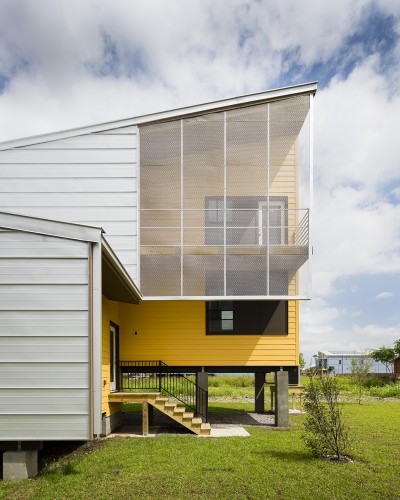The Plantations
There is a sense of romance when one talks about the "Old South". The finery, the culture, the dresses, the balls it's all very charming. However, we can never forget that all this luxury was built off the back of hypocrisy and slavery. Now, technically, Louisiana was not part of the "Old South" as it was not a state during the Revolutionary War, it was more correctly part of the "Antebellum South" which was prominent during the four score and seven or so years between the Revolutionary War and the Civil War. On our trip up the river, we drove by several fine homes, but for the sake of time, let's look at two. Which are:
Oak Alley Plantation and Laura Plantation.
Let's start with the grander "Oak Alley"
The trees of Oak Alley were present long before the house was built in 1837 as the trees are expected to be about 300 years old. The stately home was constructed via the funding of Jacques Telesphore Roman for his wife Celina.
Celina's father was Gilbert Joseph Pilie a noted architect and probable designer of the plantation. While Jacques had been unofficially dubbed "The Sugar King" of New Orleans, he died about 10 years after the house construction and despite marital woes, left the plantation in the care of his wife. It is important to note that Celina was as bad at business as she was good at throwing parties. Nearing bankruptcy in 1859, the eldest son, Henri Roman took control of the property, but by then they were too deep in debt to turn it around. Before long the union soldiers came down the bayou and the Romans were forced to sell their fine and financially unsustainable home.
It was left in disrepair until it was bought and restored in the 1920s.
The architecture of it is just phenomenal. It's one of those places that's hard to describe why it works, it just does. Nature does not build in straight lines, but somehow this places feels so natural. As far as the design goes, it's a perfect balance of natural elements and man-made possession of landscape. It's real purdy.
The second plantation we will look at is the Laura Plantation.
Unlike Oak Alley, Laura stayed firmly in the hands of the same family since it's construction in the early 1800s. That is until the last owner, Laura Locoul Gore (the fourth owner in a direct line of succession) gave it up to move to St. Louis. The architecture is clearly much more Creole and Caribbean based than that of Oak Alley. The colors, the decoration and the functionality are much more condensed, much less focused on entertaining. Like Oak Alley, the kitchen is off to the side to take away from the heat, practical and interesting flow-wise.
However, Laura Plantation is clearly a working house, vs. Oak Alley which is very much about showing off. This is most clearly evident by the reception halls. In Oak Alley you feel you have arrived, at Laura, it is as if you have always been.
While there was a sort of tragic element to the fate of the Roman family, I have to say I was removed from that pity for the main antagonist figure of the Laura plantation, Elizabeth Locoul.
Elizabeth was forced into ownership of the plantation when we was young, still very much a teenager. In part due to the culture around her as well as the responsibility thrust upon her at such a young age, she became a desensitized bully especially with the enslaved people on her land. She bought female slaves for breeding purposes, tried to break up families (which at the time was against French law, but not American law) and had at least one of her slaves branded on the forehead for trying to escape. It was these ugly tactics that, while keeping the plantation profitable, convinced her grand daughter, Laura, that she wanted nothing to do with running a plantation. Laura abdicated her duty in 1891 and sold the lot. In her later years, Laura wrote a book about her memories of growing up on a Creole Plantation. It's a pretty good read if you're interested. Find it here
Sadly, the home was damaged by fire in 2004 and repairs have not yet been made to restore it. Despite this, I would recommend taking a tour of it to see how different it is for all the other plantations in the area.
The Garden District
Moving closer to the city, we can find ourselves in the Garden District. This part of town is for the more suburban set. When you have lots of money, but don't want the remoteness of a plantation, nor the pressures of a house in the Quarter, which is all code for, the Americans wanted it. Many of the homes are what you would consider to be "Victorian" however, unlike the Victorian homes in Boston or Denver, it's just too hot to have the layering affect that mansions of that time were so famous for. Instead, the Garden District houses combine the best of the creole row homes, especially in regards to the porches, with the basics of Victorian architecture. As a result, the houses are large and open. Also, they are frequently adjacent to huge gardens, which gives the district it's name.
The best way to see this neighborhood is by street car. Here are some examples of the kind of houses you're likely to find in this part of town.
While touring, we were able to stop by the The Columns Hotel which is a bed and breakfast. Staying there was out of our price range, but tea in Albertine room was not.
While we were there, people brought up about five times that the house is where the movie 'Pretty Baby' was filmed. Maybe I'm an uncultured closed minded plebeian but that movie gives me the creeps. The straight up Game of Thrones creeps.
Why? Well, here's the trailer.
Gross.
Secondly, this is the Garden District, Storyville is on the other side of town, just saying. But if you're into sordid histories, Storyville is for you. It's one of those "if you're going to do that sort of thing, could you do it over there" type places.
While we're here, I know it's technically not part of the Garden District, but it was part of our Trolley Line so let's cover it.
One of my favorites of the City: The Piazza D'Italia.
In 1970s the leaders of the Italian Population of New Orleans sought a monument to honor their contribution to the Crescent City. In 1974 former Dean of the Yale School of Architecture, Charles Moore took the bait and designed the most pop of pop art, the most post-modern thing ever: The Piazza D'Italia. The Piazza had a rough start: as soon as it was completed and getting settled into the city, there was a drop in the interest of domestic oil production which meant that the community that surrounded it withered. It was almost lost as a "Post Modern Ruin" until a renovation in 2003-2004 by the Lowes Hotel Company.
I was surprised not only by how much I liked it, but also how well it was crafted. The jokes are perfectly timed:
-Architect Head Sculpture spits water onto the viewer
-The columns are just for show
-Flying buttress for some reason
-NEON!
-It is literally a map of Italy
There have always been mixed feelings about post-modernism in architecture. I had a professor in college who refused to even say the name James Wines because it caused too much controversy. On the one side some architects will note that Post-Modernism is a cheap shot, an easy out, a way of mocking the beliefs of others while contributing nothing yourself.
However, if you like Post-modernism, you see it as a witty, charming, tongue-in-cheek way of seeing the world. It doesn't always have to be significant to be meaningful, sometimes it can just be silly and still resonate with the viewer. Po-Mo moments like the Piazza D'Italia, are like the fool in King Lear, it's garish and loud but sometimes the jokes can more accurately describe the situation than the stone faced report.
I guess the best way to describe the Piazza's appeal is with this metaphor:
is kind of like:
but more sophisticated. So really it's the most like this:
and now to totally switch gears....
The Lower Ninth Ward:
In late August of 2005 a force of unprecedented impact struck the coast of the Southern United States with the heedless determination of a wild beast, destroying everything man and God had wrought there. The impact was undeniable, the blame for the aftermath was shoved and passed from person to person, agency to agency, derision infectious and despair insurmountable.
Hurricane Katrina is now as woven into the fabric of New Orleans as much as any other siginificant portion of their history. The haunted memories of long since past invasions, deadly plagues and all consuming fires were in one fell swoop eclipsed and washed away by the storm. However, seven years later, we see what makes people fall in love with New Orleans. It is not only the music, the color, the passion; it is the determination within its' people. They survive, and always will.
This is not to say that the problem is solved: "Mission Accomplished", far from it in fact. However, it does afford us an opportunity to look at the Ninth ward then and now.
Prior to 2005, the Ninth ward was famous for it's characteristic abundance of shotgun houses. Originally the area had been plantation land which was then adapted into military housing related to the Jackson Barracks (circa 1830). The neighborhood slowly grew over until it was as much part of New Orleans as the Garden District or the French Quarter. What held the water back in this area (as we mentioned earlier, most of the city is below sea level), was a series of levees along the adjacent canals.
One of these levees had broken during Hurricane Betsy in 1965, the damage from this was monumental. It was in reaction to this storm that President L.B. Johnson stated on his visit to oversee the damage: "I am here because I want to see with my own eyes what the unhappy alliance of wind and water have done to this land and to its good people." This visit prompted the Flood Control Act of 1965 which resulted in the design and maintenance of the levees being handed to the Army Corps of Engineers.
When Katrina hit, several levees broke, and despite the mandatory evacuation of the area, the storm resulted in the death of over 1600 people and billions of dollars worth of damage. I am unfit to properly categorize what this meant to the city as a whole as the aftermath is both measurable and immeasurable. You can put a price on a house, but what about a life? For further information I would recommend Chris Rose's 1 Dead in Attic
The immediate response was to give those displaced temporary shelter, which turned out to create even more problems, as some of the poorly constructed trailers were laced with toxic chemicals, creating severe health risks.
In the years following the disaster and its aftermath, a series of sustainability friendly non-profits started drawing its attention to New Orleans, in particular the Lower Ninth Ward, where the damage had been greatest. Including but not exclusive to, LowerNine, Habitat for Humanity, and most famously, Make it Right. Most people are acquainted with Make it Right as one of their spokespersons is an almost universally recognizable figure. That's right.
Bob Vila.
Come on. We all know it's Brad Pitt:
It's an example of using your celebrity for good and as glibly as it portrays the sometimes shallow reasons for supporting charity, let's use it as a means to an end. I mean, at the end of the day, who are you going to give money to:
 --This guy.
--This guy.Or
 ---- This guy.
---- This guy.The correct answer is both of these dudes. Because they both support worthy causes.
However, while Jimmy Carter's outfit is typically more homogeneous, Make it Right has the advantage of celebrity and with that in mind arranged for some of the best architects in the world to design their homes. (Click on the names to see what they are most famous for).
Shigeru Ban
Hitoshi Abe
Bild
Frank Gehry
Yes, each one is a fascinating take on what a shotgun house lot can allow for. Clearly crafted by masters of the trade, creole influences, contemporary technology, functionality and just the right amount of ego. I am excited to see how they age as well.
When we first got to New Orleans I was especially interested in seeing the Make it Right houses as I had read so much about them. However, I was lost as to how to find them, as no addresses were listed on any website. This reminded me of the paradox of architectural interest, especially when it comes to residential works: on one side, you are curious about the object as an aesthetic piece, on the other, these are people's homes and you should respect their privacy. There in lies the darker side of celebrity endorsement, people are interested in helping, but they also want to see the result and take their share of pride.
While I did find the streets that the Make it Right houses were located on, I will not post it here. The important thing is that, should you want to see them, you should drive the whole area to see the place and also probably donate to the cause of rebuilding it.
The other interesting side of this development is the aging that has taken place thus far. On one end of the spectrum are the Make it Right houses that embrace nature, on the other, is the consuming methods of Nature itself. With the sharp decrease in population (about 1/2 from 2000 to 2010 according to the census) many places have been abandoned, leading them to be reclaimed by selfish nature of plants and man. For more information on this phenomenon, see point and counterpoint.
Conclusion:
New Orleans, city of music, dark sides, light sides and everything in between. She is a romantic survivor, she is Carmen, you will love her, she will leave you broken hearted but you can never blame her for it. She is not to be trusted and always to be adored.























It sounds like you had a great trip. I would love to go down there and visit them. I don't share in your enthusiasm for these homes. In response to your comment, "I am excited to see how they age as well." The only thing that comes to mind for me is, "like any other piece of shit."
ReplyDeleteI know they're built "sustainably" and use wonderful materials. I'm not knocking the use of green technologies. After-all, I have a BA in Environmental Studies and have been a professional advocate. I guess the thing that appears to be missing is context, culture, charm and - above all - sense of community. The public realm around these buildings appears to be non-existant.
I hope I'm wrong.